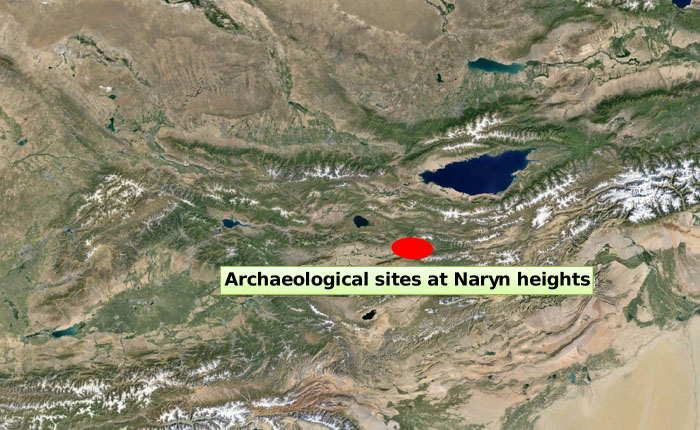| <Naryn heights> |
 |
Were the developmental processes of the nomadic societies of Central Asia the same as those of West Asia, where the animal domestication had first appeared, and its marginal zones where the domestication had secondarily reached from West Asia?
In order to answer this question, we will carry out a comparative research within developmental processes of the nomadic societies of Central Asia, adopting the method which we used in the Bishri region.
In Central Asia, not many evidence-rich field research has been carried out, only hypothetical models having been proposed.
One of the two major hypotheses advocates that the nomadic groups of the northern shores of the Black Sea migrated to Central Asia in the 4th to the 2nd Millennia B. C. (M. Gimbutas, Bronze Age cultures in central and eastern Europe, 1965).
The another hypothesis advocates that the hunter-gatherers or agriculturists of Central Asia in the 4th to the 2nd Millennia B. C. changed their subsistence means to nomadism (M. Frachetti. In Current Anthropology 53/1, 2012).
Needless to say, both of these two hypotheses have to be examined by further research.
The present research, therefore, aims to comparatively examine the developmental processes of the nomad societies of West Asia and of its marginal regions, and further of East Asia, taking into consideration the geographical setting of Kyrgyzstan which borders West Asia in its western part and China in its south-western part by the Tian Shan Mountains.
Plans of research activities
We are planning the activities below to clarify our main research themes.
1) Mapping of prehistoric and historic sites through surveys in the northern foothills of the Tian Shan Mountains and studies of the settlement patterns such as the changes of the numbers, scales and locations of the sites.
2) Post-survey soundings or excavations at the settlements or graves that are dated to the 4th to the 2nd Millennia B. C., where we can trace and date the developmental processes of the nomad societies on the bases of the settlement patterns, subsistence ways and relations with the surrounding regions.
3) Studies of the characteristics of the nomad societies of Kyrgyzstan by reviewing the old hypotheses, and proposal of a new hypothesis concerning variations in Central Asia and West Asia.
Research originality
1) Our research may contribute to the clarification of the important subjects associated with the movements of the Indo-European language groups and the formations of the horse-riding nomad societies. These subjects have been treated by many scholars such as Gordon Childe ever since the beginning of the 20th century. It is not deniable, however, that the associated research in Central Asia has not progressed so well, due to the lack of academic correspondence between Central Asia and Europe which resulted from the political and linguistic barriers during the Soviet Union period. Field works in Kyrgyzstan by foreign expeditions including the Japanese are being only sporadicly undertaken nowadays, and it is hoped that the archaeo-historical information to be yielded from the region may present useful information in the research field concerned.
2) We are planning to undertake an archaeology-based, comparative research, using the original data which we have accumulated in West Asia. The regions for archaeological research are highly specialized and sub-divided nowadays, but our research covers the large part of Eurasia from West Asia to Central Asia.
Expected research results
Kyrgyzstan is rich in archaeological sites of various periods, such as the sites of the Middle Palaeolithic periods when the archaic Homo sapiens is thought to have reached via West Asia after the Out of Africa, the sites of the Neolithic periods when the domestication of animals and crops is thought to have reached from West Asia, and the sites of the Bronze Age and historical periods when the nomad societies are thought to have dramaticly developed.
It is possible, therefore, to carry out a diachronic research to trace back to remote antiquity to clarify several subjects as below.
1) How the archaic Homo sapiens appeared in Central Asia.
2) Formation processes of the horse-riding nomad societies peculiar to Central Asia.
3) How the technologies of metal working, animal herding and plant cultivation in Central Asia were related to West Asia and East Asia.
4) How the Huns and the Turkics, who played important roles in the Eurasian history, appeared in Central Asia.
|
|